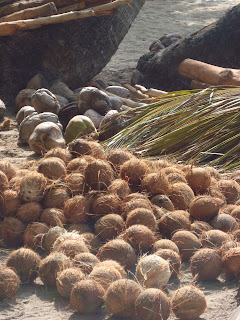パナマのインテリオール(内地)へ行ってきました。フィールドトリップの付き添いだったので、社会科見学好きな私にはとっても興味深い体験ができた4日間でした。
3日目にカメラを持って行き忘れたので、パイナップル畑の写真がとれなかったのは本当に残念でした・・・。
3日目にカメラを持って行き忘れたので、パイナップル畑の写真がとれなかったのは本当に残念でした・・・。

最初のストップはエルカニョにある、国立公園。16世紀にスペイン人が入植した時には200万人ものインディアンが住んでいたという、コクレ県の遺跡。名前さえもついていないこの遺跡は、パナマの悪の根源を象徴しているような場所。癒着が横行していて公共インフラの整備がまったく進まないパナマ政府。この遺跡も1975年までほったらかしになっていたため、めぼしい遺物(石像や貴金属など)は、アンティークコレクターにもっていかれ放題になっていたそうです。いまだに発掘は終わっておらず、2000年前の遺骨も雨にふっきさらし。お粗末な博物館(というか掘っ立て小屋)では、スミソニアンの研究員が発掘作業をしていました。この地域は、肥沃な土地であり、また海も川も山も近くだったので、マヤ文明の重要な交易地として、かなり栄えたそうです。研究費が政府からおりないため、どの種族が住んでいたのかなどの研究がまったくされないままに今日に至っています。サトウキビ畑を拡大するために、ほとんどの古墳は掘り返され、またアメリカやヨーロッパに遺物が流出してしまったため、この先もこの文明の歴史が明かされる可能性は低いとのことでした。悲しいことです。発掘(というか泥棒)された遺物のほとんどは、アメリカの美術館(名前は失念)にあるそうです。
次のストップは、塩田。塩田を見るのは初めてだったので、感動でした。デスバレー並みの乾燥&高温地域なので、長い間外にいられませんでしたが、毎日口にしているお塩がどんな風に作られるのか見られたのは貴重な体験でした。しかし、ガイドもいなければお土産を買うところもなし。さすがパナマ。地面に盛られているお塩をなめてみたら、しょっぱかった!ってあたりまえか。
お次は砂糖工場。これまた初体験。写真はサトウキビの山です。サトウキビの収穫から精製までを行っているこの工場、ものすごく暑かったです。砂糖をとりまく貧困と植民地政策のレガシーなんてことをグルグル考えながら見学しました。こんな暑いところで、手でサトウキビを収穫している人々に本当に感謝です。(パイナップル農園でも同じことを考えさせられました。パイナップルを植えるのも収穫するのも全て手作業。1株植えて、1円の稼ぎというのを聞いた時には、炎天下の空の下、倒れるかと思いました。しかも、その1株からは1年に1つのパイナップルしか取れないなんて、驚きでした。大好きなパイナップルを生産してくれている人たちに感謝しました。)
今回の滞在地は、コスタリカとの国境にある、Chiriqui (チリキ)地方。パナマシティから車で約9時間の長旅でした。チリキ県の中でも今回泊まった場所はパナマで一番高い山がある高山地帯で、パナマのスイスと呼ばれてます。よって、シティで食べられる野菜や苺は全てこの地域で栽培されています。久しぶりの涼しい気候に心から感動でした。5ヶ月ぶりに袖を通す長袖!

コーヒーファーム&工場の見学もしました。コーヒーは毎日3杯くらい飲んでる程のコーヒー好きですが、生産現場を目にするのはこれが始めて。写真の豆は、輸出前の状態で、ロースト前の豆です。この工程に入る前に、なんと1年間もかけて豆を乾燥させるのだそうです。コーヒーの収穫もこれまた全て手作業で、労働はインディアンによって行われています。100パウンド分の豆をつんで、たったの1ドル25セントにしかならないそうです。フェアトレードコーヒーをこれからも買わなければいけないと心に誓った瞬間でした。パイナップルもコーヒーも、一番グレードが高いものは全て輸出されるそうです。ネオ・コロニアリズムをまさに目にして、とても複雑な気持ちに・・・。ローカル主導でフェアに食料が生産されることを願わずにはいられませんでした。
最後に、馬のランチにも見学にいきました。これまた、ビジネスライクな馬の生産状況に驚愕してしまいました。ジョッキーをしているという人によると、この生産状況は第三世界で特にひどいそうです。ヨーロッパでは動物愛護団体が厳しく規制をしているそうで。景色はきれいだったし、生まれて1日しかたっていない馬を見ることができたし、とても貴重な体験でした。しかし、しかし、しかし、いろいろ考えさせられました。
今回の旅でまたひとつ多く、パナマのことを知ることができました。なんだか長いエントリーになってしまったので、この辺で。
今回の旅でまたひとつ多く、パナマのことを知ることができました。なんだか長いエントリーになってしまったので、この辺で。




















